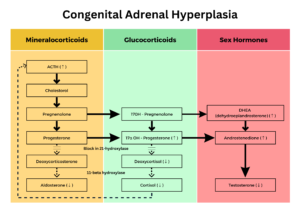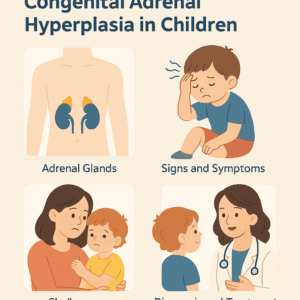What Is CAH?
Congenital Adrenal Hyperplasia (CAH) is a group of inherited disorders that affect how the adrenal glands produce essential hormones. These glands sit on top of the kidneys and are responsible for releasing:
-
Cortisol – helps regulate stress response, blood sugar, and metabolism
-
Aldosterone – helps maintain blood pressure and salt balance
-
Androgens – male sex hormones involved in puberty and development
The most common cause of CAH is a mutation in the CYP21A2 gene, leading to a deficiency of the enzyme 21-hydroxylase. This causes the body to produce too little cortisol and aldosterone, and too much androgen.

Common Symptoms in Children
CAH symptoms can appear within days of birth, especially in the classic form, and vary between boys and girls.
In newborns (both sexes):
-
Vomiting and poor feeding
-
Dehydration
-
Unusual skin darkening
-
Low blood pressure
-
Failure to gain weight
-
Lethargy
In girls:
-
Ambiguous genitalia at birth
-
Early signs of puberty (e.g. pubic hair, rapid growth)
In boys:
-
Typically normal-looking genitals at birth (delays diagnosis)
-
Early development of male traits such as deep voice, body odor, enlarged genitals
In both genders:
-
Salt-wasting crisis (in severe forms): loss of sodium, leading to dehydration, low blood pressure, and potential shock if untreated
How Is CAH Diagnosed?
In the United States and many countries, CAH is included in routine newborn screening programs. A small blood sample is tested for elevated levels of 17-hydroxyprogesterone, which indicates adrenal dysfunction.
If results are abnormal, further tests are conducted, including:
-
Hormone level testing
-
Electrolyte analysis (sodium and potassium)
-
Genetic testing to confirm mutations in the CYP21A2 gene
Early detection allows for prompt treatment, which can prevent life-threatening complications and support normal growth and development.
Treatment and Management
While CAH cannot be cured, it can be effectively managed with lifelong hormone replacement therapy.
Standard treatments include:
-
Hydrocortisone – replaces the missing cortisol
-
Fludrocortisone – replaces aldosterone (for salt-wasting forms)
-
Salt supplements – often necessary for infants
During times of stress (illness, injury, surgery):
-
Children may need higher “stress doses” of steroids
-
Emergency steroid injections may be required to avoid adrenal crisis
-
Parents are trained to recognize symptoms and administer medication promptly
In some girls with ambiguous genitalia:
-
Surgery may be offered in infancy or later
-
Support from psychologists and endocrinologists helps families navigate sensitive decisions
Long-term care includes:
-
Regular follow-up with a pediatric endocrinologist
-
Bloodwork and growth monitoring
-
Adjusting medication as the child grows
-
Ongoing education for the family and child
The Role of Parents and Caregivers
Managing CAH is a team effort—and parents are at the center of it. Their role goes far beyond giving daily medication.
Parents are responsible for:
-
Monitoring for signs of adrenal crisis
-
Adjusting medication during illness
-
Keeping emergency steroid kits at home, school, and during travel
-
Educating teachers, caregivers, and family members about the condition
-
Supporting the child emotionally as they learn about and manage their health
-
Ensuring their child wears a medical alert bracelet for safety
Many families also find support in CAH communities, online groups, or organizations dedicated to adrenal disorders.
Conclusion
Congenital Adrenal Hyperplasia is rare, but manageable. With early diagnosis, proper treatment, and lifelong care, children with CAH can grow up to live full, healthy, and confident lives.
Raising awareness is key. The more parents and healthcare professionals know about CAH, the faster children can get the help they need. And for families already living with CAH, the message is clear: you’re not alone—and your child’s future can be bright.

